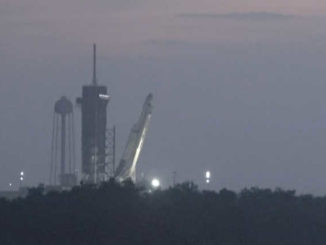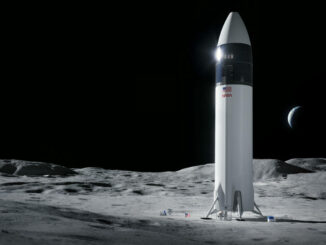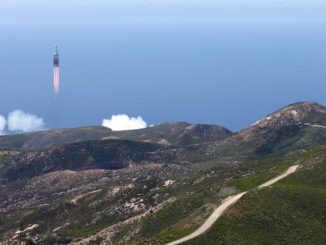
Officials with Canadian Earth observation company UrtheCast, which owns two cameras on the International Space Station’s Russian service module, outlined plans this week to install a remote sensing camera and a radar imaging payload on the outpost’s U.S.-owned Tranquility module in 2017.
Going a step beyond its cameras manually mounted on the Russian part of the space station by cosmonauts on a spacewalk, UrtheCast plans to develop and launch a deployable camera and radar antenna in the trunk of a SpaceX Dragon cargo ship.
After the Dragon supply craft arrives at the complex, the space station’s Canadian-built robotics system will detach the instrument package and place it on a vacant docking port on the Tranquility module, also known as Node 3.
“Once the thing is intalled, we have these little gimbals that open up and deploy the two sets of instruments — both the optical instrument with our own dedicated X-band 1 gigabit per second downlink, and then the radar payload as well,” said Wade Larson, president and chief operating officer of UrtheCast.
Larson declined to reveal the cost of the project, but he touted the sensors as the largest purely commercial investment to use the space station platform to date.
The UrtheCast sensor package includes an optical camera capable of shooting still images or video at 40-centimeter, or 15.7-inch, resolution in color. The unit also features a nearly 100-square-foot radar antenna to collect all-weather, day-and-night imagery of Earth in L-band and X-band, Larson said.
“Both of those instruments are utterly unique,” Larson said. “Nothing like them has ever flown before in space.”

Despite the limitations of the space station’s orbit, which does not cover the entire planet and crosses over territory at a different time every day, Larson said simultaneous optical and radar imagery of the ground from the same viewing angle will differentiate UrtheCast from other commercial Earth observation systems.
“We think the information content which comes out of that is going to be enormously of interest to our user community, both institutional and government,” Larson said. “Ultimately, our hope is to democratize this data, put it out on a web platform and make it available to everyone in the world, basically for free.”
UrtheCast’s next-generation Earth observation system also has a miniature pressurized module dubbed the Lightweight UrtheCast NanoRacks Alcove, or LUNA. The module will be accessible from a berthing mechanism on the Tranquility module, allowing astronauts to set up electronics and service the system, according to George Tyc, chief technology officer for Vancouver, British Columbia-based UrtheCast.
“Once it’s attached, the astronauts open the hatch from the inside,” Tyc said. “They can stuff the electronics into the lockers and plug it all in.”
Larson said UrtheCast was a few weeks away from selecting a contractor to build the Earth-viewing suite, which will be designed to operate for at least seven years up to 2024.
One camera owned by UrtheCast attached to the shell of the Russian Zvezda service module is producing commercially-available medium-resolution imagery at 5-meter (16.4-foot) resolution.
UrtheCast’s other camera, a high-resolution instrument capable of recording videos, is mounted on a gimbal platform to point toward targets away from the space station’s ground path.
Engineers found trouble with the high-resolution camera’s pointing mechanism, but Tyc said UrtheCast hopes the sharp-eyed imager will be operational in a few months. In July, UrtheCast said it was manufacturing cables for launch to the space station to solve the problem.
“We’re in the final commissioning stage on the high-resolution camera, going through some final checkout on the BPP, the pointing platform, and we’ll be entering operations with that in December,” Larson said.
UrtheCast and partner NanoRacks, a Houston-based company specializing in supporting commercial research on the space station, discussed the Earth observation project at the 65th Astronautical Congress here.
“I really believe that UrtheCast is poised to totally disrupt the traditional Earth resources multi-billion dollar market as to how you get the data,” said Jeffrey Manber, managing director of NanoRacks. “Up to now, it’s been assumed that you’ve got to have a dedicated satellite, you have to have dedicated launchers, you have to have finite power, you have a limited lifespan on the platform. What UrtheCast is doing, in my view, is demonstrating the disruptive power of a permanently manned space station, that you can use that platform as a big satellite with total power, things can be fixed, and launches are not as important once you’re up there.”
NanoRacks has arranged the delivery of small commercial research experiments to the space station, and the launch of CubeSats from a deployer outside the station’s Japanese research lab.
“It’s really exciting for me how UrtheCast is putting the International Space Station front and center as a solution and as a tool for the continued growth of the commercial Earth observation market,” Manber told reporters.
UrtheCast’s imaging sensors will reach the space station as several government-owned Earth science payloads will take up residence on mounting platforms outside the lab’s modules and truss backbone.
A NASA instrument designed to measure winds from orbit — data that could help predict the intensity of hurricanes — was attached on the station’s exterior this week.
In the next few years, NASA will send up at least five more sensors to monitor how human activity is changing the climate, study the ozone layer, detect lightning strikes, measure the structures of forest canopies, and collect data on the link between the water cycle and plant growth.



